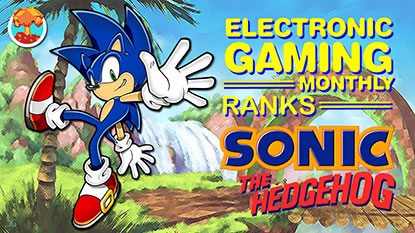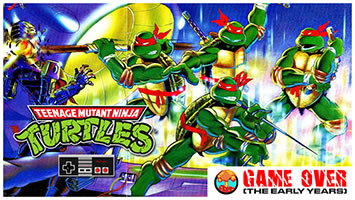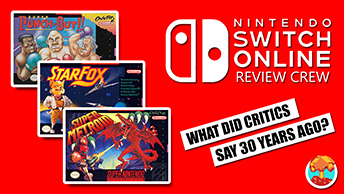- CLASSIC MAGAZINES
- REVIEW CREW
A show recapping what critics thought back
when classic games first came out! - NEXT GENERATION'S BEST & WORST
From the worst 1-star reviews to the best
5-stars can offer, this is Next Generation! - NINTENDO POWER (ARCHIVE)
Experience a variety of shows looking at the
often baffling history of Nintendo Power! - MAGAZINE RETROSPECTIVE
We're looking at the absolutely true history of
some of the most iconic game magazines ever! - SUPER PLAY'S TOP 600
The longest and most ambitious Super NES
countdown on the internet! - THEY SAID WHAT?
Debunking predictions and gossip found
in classic video game magazines! - NEXT GENERATION UNCOVERED
Cyril is back in this spin-off series, featuring the
cover critic review the art of Next Generation! - HARDCORE GAMER MAGAZING (PDF ISSUES)
Download all 36 issues of Hardcore Gamer
Magazine and relive the fun in PDF form!
- REVIEW CREW
- ELECTRONIC GAMING MONTHLY
- ELECTRONIC GAMING MONTHLY RANKS
From Mario to Sonic to Street Fighter, EGM
ranks classic game franchises and consoles! - ELECTRONIC GAMING MONTHLY BEST & WORST
Counting down EGM’s best and worst reviews
going year by year, from 1989 – 2009! - ELECTRONIC GAMING BEST & WORST AWARDS
11-part video series chronicling the ups and
downs of EGM’s Best & Worst Awards!
- ELECTRONIC GAMING MONTHLY RANKS
- GAME HISTORY
- GAME OVER: STORY BREAKDOWNS
Long-running series breaking down game
stories and analyzing their endings! - A BRIEF HISTORY OF GAMING w/ [NAME HERE]
Real history presented in a fun and pithy
format from a variety of game historians! - THE BLACK SHEEP
A series looking back at the black sheep
entries in popular game franchises! - INSTANT EXPERT
Everything you could possibly want to know
about a wide variety of gaming topics! - FREEZE FRAME
When something familiar happens in the games
industry, we're there to take a picture! - I'VE GOT YOUR NUMBER
Learn real video game history through a series
of number-themed episodes, starting at zero! - GREAT MOMENTS IN BAD ACTING
A joyous celebration of some of gaming's
absolute worst voice acting!
- GAME OVER: STORY BREAKDOWNS
- POPULAR SHOWS
- DG NEWS w/ LORNE RISELEY
Newsman Lorne Riseley hosts a regular
series looking at the hottest gaming news! - REVIEW REWIND
Cyril replays a game he reviewed 10+ years
ago to see if he got it right or wrong! - ON-RUNNING FEUDS
Defunct Games' longest-running show, with
editorials, observations and other fun oddities! - DEFUNCT GAMES QUIZ (ARCHIVE)
From online quizzes to game shows, we're
putting your video game knowledge to the test!- QUIZ: ONLINE PASS
Take a weekly quiz to see how well you know
the news and current gaming events! - QUIZ: KNOW THE GAME
One-on-one quiz show where contestants
find out if they actually know classic games! - QUIZ: THE LEADERBOARD
Can you guess the game based on the classic
review? Find out with The Leaderboard!
- QUIZ: ONLINE PASS
- DEFUNCT GAMES VS.
Cyril and the Defunct Games staff isn't afraid
to choose their favorite games and more! - CYRIL READS WORLDS OF POWER
Defunct Games recreates classic game
novelizations through the audio book format!
- DG NEWS w/ LORNE RISELEY
- COMEDY
- GAME EXPECTANCY
How long will your favorite hero live? We crunch
the numbers in this series about dying! - VIDEO GAME ADVICE
Famous game characters answer real personal
advice questions with a humorous slant! - FAKE GAMES: GUERILLA SCRAPBOOK
A long-running series about fake games and
the people who love them (covers included)! - WORST GAME EVER
A contest that attempts to create the worst
video game ever made, complete with covers! - LEVEL 1 STORIES
Literature based on the first stages of some
of your favorite classic video games! - THE COVER CRITIC
One of Defunct Games' earliest shows, Cover
Critic digs up some of the worst box art ever! - COMMERCIAL BREAK
Take a trip through some of the best and
worst video game advertisements of all time! - COMIC BOOK MODS
You've never seen comics like this before.
A curious mix of rewritten video game comics!
- GAME EXPECTANCY
- SERIES ARCHIVE
- NINTENDO SWITCH ONLINE ARCHIVE
A regularly-updated list of every Nintendo
Switch Online release, plus links to review! - PLAYSTATION PLUS CLASSIC ARCHIVE
A comprehensive list of every PlayStation
Plus classic release, including links! - RETRO-BIT PUBLISHING ARCHIVE
A regularly-updated list of every Retro-Bit
game released! - REVIEW MARATHONS w/ ADAM WALLACE
Join critic Adam Wallace as he takes us on a
classic review marathon with different themes!- DEFUNCT GAMES GOLF CLUB
Adam Wallace takes to the links to slice his way
through 72 classic golf game reviews! - 007 IN PIXELS
Adam Wallace takes on the world's greatest spy
as he reviews 15 weeks of James Bond games! - A SALUTE TO VAMPIRES
Adam Wallace is sinking his teeth into a series
covering Castlevania, BloodRayne and more! - CAPCOM'S CURSE
Adam Wallace is celebrating 13 days of Halloween
with a line-up of Capcom's scariest games! - THE FALL OF SUPERMAN
Adam Wallace is a man of steel for playing
some of the absolute worst Superman games! - THE 31 GAMES OF HALLOWEEN
Adam Wallace spends every day of October afraid
as he reviews some of the scariest games ever! - 12 WEEKS OF STAR TREK
Adam Wallace boldly goes where no critic has
gone before in this Star Trek marathon!
- DEFUNCT GAMES GOLF CLUB
- DAYS OF CHRISTMAS (ARCHIVE)
Annual holiday series with themed-episodes
that date all the way back to 2001!- 2015: 30 Ridiculous Retro Rumors
- 2014: 29 Magazines of Christmas
- 2013: 29 Questionable Power-Ups of Christmas
- 2012: 34 Theme Songs of Christmas
- 2011: 32 Game Endings of Christmas
- 2010: 31 Bonus Levels of Christmas
- 2009: 30 Genres of Christmas
- 2008: 29 Controls of Christmas
- 2007: 34 Cliches of Christmas
- 2006: 33 Consoles of Christmas
- 2005: 32 Articles of Christmas
- 2004: 31 Websites of Christmas
- 2003: 29 Issues of Christmas
- 2002: 28 Years of Christmas
- 2001: 33 Days of Christmas
- NINTENDO SWITCH ONLINE ARCHIVE
- REVIEW ARCHIVE
- FULL ARCHIVE
What's Wrong With the Official Sega Genesis Seal of Quality?
After the game crash of 1983, first-party companies like Nintendo and Sega were quick to learn the lessons of their forefathers. Gone were the days of being able to shovel any old product to the market; publishers had to be much more selective if they planned on keeping the video games industry afloat.
Sega had an even bigger obstacle to overcome. Thanks to Nintendo's strong-arm tactics, third parties were kept from publishing games on other platforms. This meant that Sega would have to look beyond the usual players and find a ragtag group of publishers made up of arcade makers, second-generation console veterans and foreign companies looking to break into the United States.
With names like Kaneko, RazorSoft, Nuvision and Renovation, they were a motley crew with a largely unproven track record. But that didn't stop Sega from bestowing them with the highest honor they could give, the Official Sega Genesis Seal of Quality. And just to make it official, the company ran a two-page ad announcing this dream team to the world.
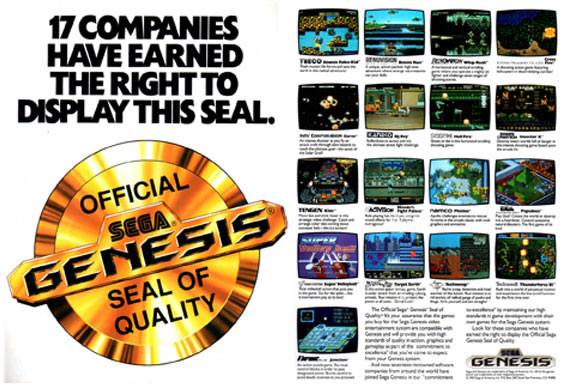
While not as flashy as Nintendo's third-party line-up, there are a few gems in the crowd. Bimimi Run and Whip Rush are underrated action games, and the critics went crazy over Technosoft's Thunder Force III. I've gone on record praising DJ Boy, Populous was fantastic on the PC, Technocop is insanely violent and Atomic Robo-Kid is a franchise in serious need of a resurrection. It might not be an attractive group, but there are a lot of good games featured in this advertisement.
 Unfortunately, consumers weren't interested in this "commitment of excellence." Looking over the seventeen companies featured, only a few remain. While a few made it into the 21st century, most of Sega's early support died before Bill Clinton's second term.
Unfortunately, consumers weren't interested in this "commitment of excellence." Looking over the seventeen companies featured, only a few remain. While a few made it into the 21st century, most of Sega's early support died before Bill Clinton's second term.
This was the fate of Sage's Creation, which published Shadow Blasters, Crack Down, Ka-Ge-Ki: Fists of Steel and King Salmon: The Big Catch before closing shop in 1992. Nuvision's Bimimi Run may have been well-received by critics, but that wasn't enough to get Bean Ball Benny, Swamp Thing and Guardian Angels Safety Patrol published.
With hits like El Viento, Ys III: Wanderers of Ys, Syd of Valis and Time Gal, Renovation published some of the most memorable games of the 16-bit era. But like Treco (Fighting Masters) and RazorSoft (Stormlord), Renovation ended their run in the early 1990s.
Treco (Fighting Masters) and RazorSoft (Stormlord), Renovation ended their run in the early 1990s.
There are a few familiar names, including Tengen. Tengen is best known for their sought-after Tetris cartridge and unlicensed Nintendo Entertainment System arcade ports. They managed to get the seal of quality on the Sega Genesis, leading to disappointing releases like Paperboy 2, Pit-Fighter, Slap Fight MD and Race Drivin'. Sadly, none of this was enough to keep Tengen afloat. The company went under in 1994.
Then there are companies that didn't even get around to publishing Genesis games. INTV Corporation was prepared to bring Curse to Sega's 16-bitter, but apparently something fell through. And before you ask, Target Earth was not made by the same people that brought you Shrek. There are two different companies with the name Dreamworks. Go figure.
So how many of the 17 companies still publish games? As you have probably already guessed, the answer isn't pretty. Below you'll find an updated version of the ad, highlighting only the companies still alive and kicking.
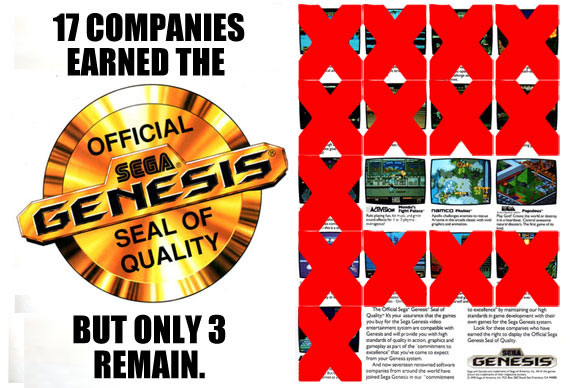
As you can see, only three companies remain -- Activision, Namco and Electronic Arts. These companies bet on the Sega Genesis, which certainly helped propel them to the next level. Mondu's Fight Palace, Phelios and Populous aren't exactly the banner games from these companies, but the Genesis did eventually see Rolling Thunder 2, Pitfall: The Mayan Adventure and Road Rash.
As we continue to see large and small game companies close their doors, it's important to remember that this is just a part of the business. Even with the seal of quality, this is a harsh industry and success is never guaranteed. All we can do is enjoy the games while they're here.






Sega had an even bigger obstacle to overcome. Thanks to Nintendo's strong-arm tactics, third parties were kept from publishing games on other platforms. This meant that Sega would have to look beyond the usual players and find a ragtag group of publishers made up of arcade makers, second-generation console veterans and foreign companies looking to break into the United States.
With names like Kaneko, RazorSoft, Nuvision and Renovation, they were a motley crew with a largely unproven track record. But that didn't stop Sega from bestowing them with the highest honor they could give, the Official Sega Genesis Seal of Quality. And just to make it official, the company ran a two-page ad announcing this dream team to the world.

While not as flashy as Nintendo's third-party line-up, there are a few gems in the crowd. Bimimi Run and Whip Rush are underrated action games, and the critics went crazy over Technosoft's Thunder Force III. I've gone on record praising DJ Boy, Populous was fantastic on the PC, Technocop is insanely violent and Atomic Robo-Kid is a franchise in serious need of a resurrection. It might not be an attractive group, but there are a lot of good games featured in this advertisement.

This was the fate of Sage's Creation, which published Shadow Blasters, Crack Down, Ka-Ge-Ki: Fists of Steel and King Salmon: The Big Catch before closing shop in 1992. Nuvision's Bimimi Run may have been well-received by critics, but that wasn't enough to get Bean Ball Benny, Swamp Thing and Guardian Angels Safety Patrol published.
With hits like El Viento, Ys III: Wanderers of Ys, Syd of Valis and Time Gal, Renovation published some of the most memorable games of the 16-bit era. But like

There are a few familiar names, including Tengen. Tengen is best known for their sought-after Tetris cartridge and unlicensed Nintendo Entertainment System arcade ports. They managed to get the seal of quality on the Sega Genesis, leading to disappointing releases like Paperboy 2, Pit-Fighter, Slap Fight MD and Race Drivin'. Sadly, none of this was enough to keep Tengen afloat. The company went under in 1994.
Then there are companies that didn't even get around to publishing Genesis games. INTV Corporation was prepared to bring Curse to Sega's 16-bitter, but apparently something fell through. And before you ask, Target Earth was not made by the same people that brought you Shrek. There are two different companies with the name Dreamworks. Go figure.
So how many of the 17 companies still publish games? As you have probably already guessed, the answer isn't pretty. Below you'll find an updated version of the ad, highlighting only the companies still alive and kicking.

As you can see, only three companies remain -- Activision, Namco and Electronic Arts. These companies bet on the Sega Genesis, which certainly helped propel them to the next level. Mondu's Fight Palace, Phelios and Populous aren't exactly the banner games from these companies, but the Genesis did eventually see Rolling Thunder 2, Pitfall: The Mayan Adventure and Road Rash.
As we continue to see large and small game companies close their doors, it's important to remember that this is just a part of the business. Even with the seal of quality, this is a harsh industry and success is never guaranteed. All we can do is enjoy the games while they're here.






HOME |
CONTACT |
NOW HIRING |
WHAT IS DEFUNCT GAMES? |
NINTENDO SWITCH ONLINE |
RETRO-BIT PUBLISHING
Retro-Bit |
Switch Planet |
The Halcyon Show |
Same Name, Different Game |
Dragnix |
Press the Buttons
Game Zone Online | Hardcore Gamer | The Dreamcast Junkyard | Video Game Blogger
Dr Strife | Games For Lunch | Mondo Cool Cast | Boxed Pixels | Sega CD Universe | Gaming Trend
Game Zone Online | Hardcore Gamer | The Dreamcast Junkyard | Video Game Blogger
Dr Strife | Games For Lunch | Mondo Cool Cast | Boxed Pixels | Sega CD Universe | Gaming Trend
Copyright © 2001-2025 Defunct Games
All rights reserved. All trademarks are properties of their respective owners.
All rights reserved. All trademarks are properties of their respective owners.













